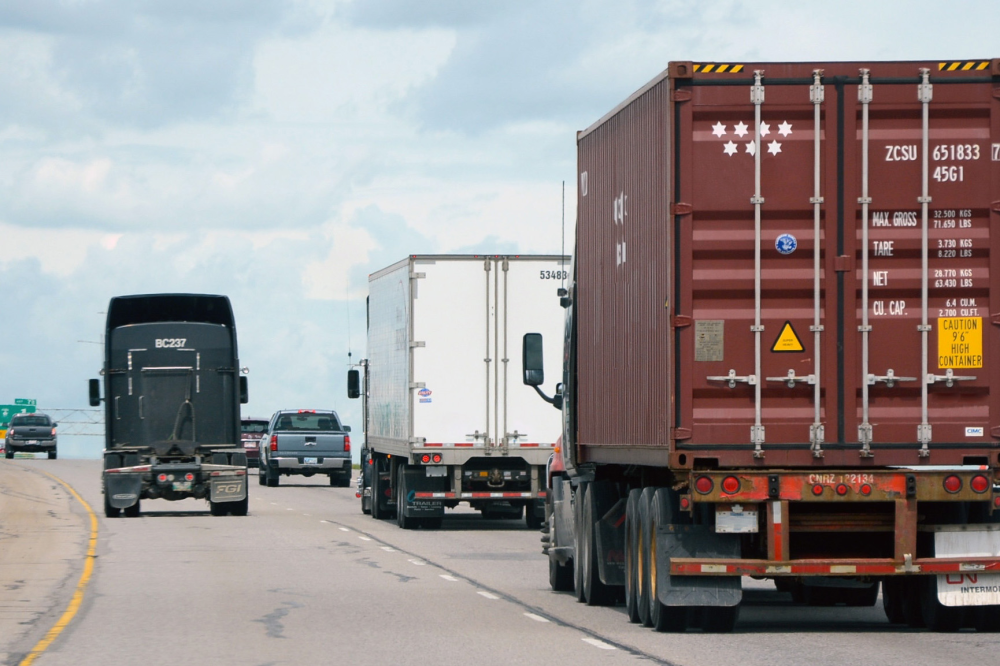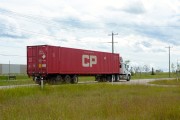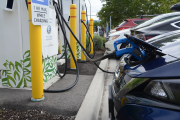As this country’s largest source of greenhouse gas (GHG) emissions after oil and gas production and the single biggest driver of oil demand, Canada’s transportation sector deserves more public attention — particularly the rising emissions from road freight.
Transportation produces nearly a quarter of Canada’s total greenhouse gas emissions. Between 1990 and 2021, GHGs from the transport sector grew by 27 per cent mostly due to increases from freight heavy-duty trucks and passenger light trucks. While emissions from passenger cars have recently begun a slow descent, emissions from medium- and heavy-duty vehicles (MHDVs) have continued to climb. Judging by the rate of increase over time, MHDV emissions will surpass those of passenger cars by 2030 even though MHDVs make up less than 20 per cent of all the vehicles on the road.
To be sure, the Government of Canada has taken steps to limit and reverse the level of greenhouse gases from transport systems. The 2030 Emissions Reduction Plan (ERP) included a series of sales targets, applicable to auto manufacturers and importers, for light-duty vehicles and a separate series of sales targets for medium- and heavy-duty vehicles (MHDVs).
In both instances, suppliers are regulated to sell a certain number of zero-emission vehicles as a percentage of total sales. The percentage increases over time until 2035 when 100 per cent of sales of passenger cars must be non-emitting and, for MHDVs, 100 per cent of sales must be either electric or hydrogen fuelled by 2040 (where feasible).
In a very short period of time — less than 20 years — the auto industry must undergo a transition of historic proportions. Yet, despite the urgency, draft regulations framing the transition off gas- and diesel-fuelled MHDVs have not been released. Nor is there a comprehensive, national plan on how the turnover from fossil-fuelled vehicles to emission-free ones will be implemented at the pace required to meet the ERP targets.
The stark reality is that, should Canada fall short of transitioning to zero-emission vehicles at the pace needed to fulfill the ERP goals, we will fail to meet the 2030 milestone of reducing national emissions by 40-to-45 per cent below 2005 levels. Worse still, it will be impossible to accomplish Canada’s global commitment to carbon neutrality by 2050.
Where do we go from here?
 In compiling the Pembina Institute’s recent report, Canada’s Pathway to Net-Zero for Medium- and Heavy-Duty Trucks and Buses, we closely considered a range of policy tools, analyzed possible outcomes, modelled various scenarios, and consulted widely with stakeholders, primarily fleet owners and operators. The results are actionable policy recommendations that provide guidance on how Canada can accelerate the shift to clean MHDV transportation at a rate that aligns with federal pledges on emission reductions without forfeiting consideration of a sustainable job market.
In compiling the Pembina Institute’s recent report, Canada’s Pathway to Net-Zero for Medium- and Heavy-Duty Trucks and Buses, we closely considered a range of policy tools, analyzed possible outcomes, modelled various scenarios, and consulted widely with stakeholders, primarily fleet owners and operators. The results are actionable policy recommendations that provide guidance on how Canada can accelerate the shift to clean MHDV transportation at a rate that aligns with federal pledges on emission reductions without forfeiting consideration of a sustainable job market.
Our analysis shows that an ambitious sales mandate is key to a successful outcome. Compared to other policies, including the carbon price and the Clean Fuel Regulations, a sales mandate is far more likely to ensure that the electrification of MHDV fleets will either meet or come very closing to meeting the ERP quotas. Conversely, under current climate policies (again, including the carbon price and the Clean Fuel Regulations), 100 per cent sales of zero-emission MHDVs by 2040 will remain well out of reach.
However, we also determined that a one-size-fits-all sales target is incompatible with the realities of the MHDV marketplace. Instead, we strongly recommend that sales targets be tied to commercial viability. Buses and most medium-duty vehicles for instance are currently the easiest to electrify. Why? Buses and last-mile delivery trucks and vans tend to run short routes, return to a central depot where they can be charged overnight, and are readily available for sale in a range of models.
Long-haul trucks on the other hand are difficult to decarbonize. Heavy-duty vehicles driven over considerable distances require greater range capacity than cars, need large, powerful batteries, and must have access to fast recharging/refuelling options, which are still in short supply.
When we factored in key variables such as market-readiness, price point, stakeholder feedback, and charging requirements, we concluded that the following sales goals for manufacturers are reasonable and aligned with climate targets:
- Most buses reach 100 per cent zero-emission vehicle sales by 2030;
- Most urban medium-size trucks and vans reach 50 per cent zero-emission vehicle sales by 2030, and near 100 per cent by 2040; and
- Heavy-duty trucks reach up to 10 per cent zero-emission sales by 2032 and near 100 per cent by 2045.
While important, the sales target alone will not be sufficient to achieve the shift we need to see. Other policies and initiatives must also be deployed such as demand-side measures to incentivize uptake and capacity building efforts to prepare the labour force for a job market that is already morphing into one dominated by electric vehicle manufacturing.
In addition, fleet operators repeatedly singled out insufficient charging infrastructure as a barrier to the adoption of zero-emission MHDVs. To be fair, the federal government has launched funding programs to support infrastructure build-out. But here again, we risk stagnation. So far, federal investment in charging and refuelling infrastructure covers only 20 per cent of the estimated cost of constructing a national network that can meet the needs of the anticipated number of MHDVs on the road by 2030.
The future is now
The magnitude of the transition called for in the transportation sector is extraordinary in the sheer scope of the social and economic changes necessitated, from mining critical minerals to upskilling and re-training the auto sector’s labour force, to new forms of production for batteries, parts and assembly.
The anticipated reduction in GHGs is likewise transformative. Should the targets we recommend be met in full and on time, MHDV emissions would decline from 35 Mt in 2020 to 10 Mt or less by mid-century and would drop by as much as 80 per cent by 2050 relative to 2020 levels.
The profile in Canada for oil demand would change drastically. Under current climate policies, demand for oil from MHDVs would decrease by 26 per cent by 2050 relative to 2020 levels. Under a scenario in which sales targets are met in full and on time, demand for oil in the MHDV sector would decrease by 80 per cent relative to 2020 levels. Essentially, fossil fuels will be replaced by clean electricity and hydrogen.
We know that an electric vehicle future is essential to clean air and healthier communities, the revival of the auto industry, and meeting global climate commitments. Now Canada must find the fastest, most direct route to get there.






